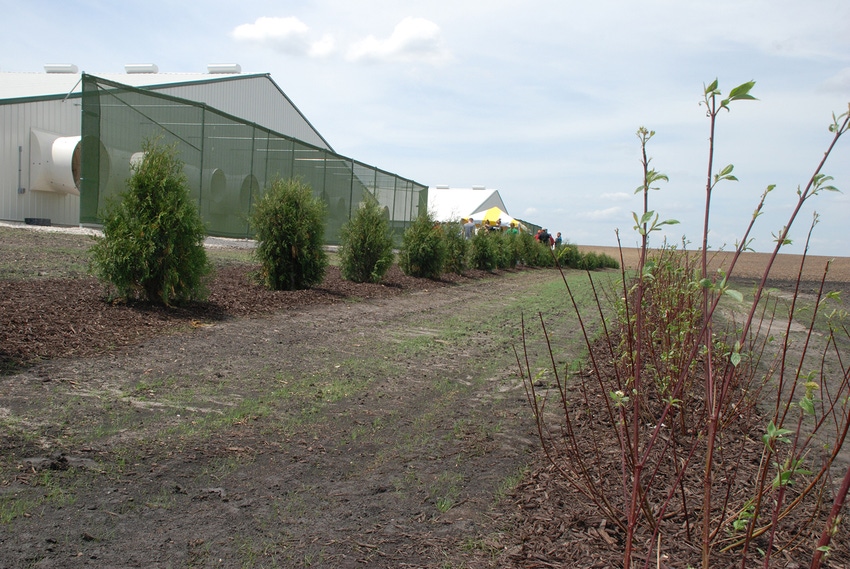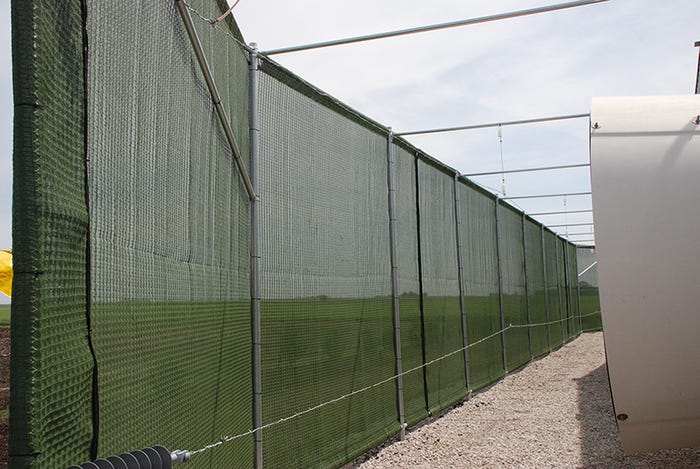A combination of old and new technology is being implemented at Iowa Select Farms’ finisher barns to abate odors.
June 19, 2018

Odor has long been a nemesis of pork producers, and it has been known to create great divides between producers and their neighbors. As long as producers have battled odor issues emanating from their swine facilities, they have also worked to find ways to abate the level of those odors.
In May, Iowa Select Farms hosted an open house of a new finishing facility, showcasing some steps the swine system is taking to be good neighbors. A combination of old and new technology is being implemented at the ISF Hale Finisher Barn near Williams, Iowa.
The old “technology” comes in the form of a windbreak of arborvitae and dogwood shrubs to stop dust and odors coming from the tunnel-ventilated wean-to-finish barn.
Tree line frames operation
John Frazier of Frazier Nursery in Vinton, Iowa, uses the analogy comparing a swine barn to a great work of art. “If you have a Picasso, you want to put a nice frame around it,” he says, “so if you have a nice hog building, you’re going to want to put trees around it because that’s framing your Picasso.”
Also, as Kent Mowrer, field specialist with the Coalition to Support Iowa’s Farmers, puts it: “If you can’t see it, you can’t smell it,” alluding to the aesthetics feature a tree line offers a farm site.
The new technology that ISF is employing at the Hale site, as well as at two other farms in the system, is an electrostatic fence consisting of two electrically charged lines of barbed wire powered with 30,000 volts that will “knock” the odor-carrying dust particles exiting the fans of the tunnel-ventilated barn.
John Stinn, environmental projects manager, says, “the electrostatic precipitator’s whole purpose is to knock down dust and control dust before it leaves the farm. If we control dust, we control odor. Odor is just a chemical compound, so that chemical has to adhere to a dust particle before it can travel.”
The high-voltage charged barbed-wire strands put off a field of electrons “so all the dust leaving the fans has to pass through that field and picks up a negative charge,” Stinn says. Those particles then seek a surface that is grounded, and the fabric fence is a perfect receptor to catch and hold the dust particles. The particles that may accumulate on the ultraviolet-resistant fabric fence will be washed off by rain, or a power washer if necessary.
The Hale Finisher Barn is the third facility that ISF has equipped with the electrostatic fence this year, and Stinn says the company is encouraged to see the results of the fence on odor reduction. He says he thinks the fence itself will abate about 50% of the odor being emitted.
Though not as optimistic about the benefits of the electrostatic fence, Daniel Andersen is also anxious to see just how well the technology works. Andersen is an assistant professor of ag and biosystems engineering at Iowa State University, and he says his team will be conducting research at the ISF facility.
Though electrostatic precipitator technology may be relatively new to the swine industry, it has been used for quite some time in other industries, such as collecting fly ash from coal-burning factories to be used in making concrete.
Transferring tech to hogs
John Baumgartner has been working with the technology in hog barns, first with his company, Baumgartner Environics, which has evolved into EPI Air that he operates with his son Matthew at Olivia, Minn.
The elder Baumgartner has been working with Jay Moore, director of Environmental Services for New Fashion Pork, on the development of this technology for swine farm applications after seeing the technology’s success in the factory setting.
Baumgartner thought that same concept could work in hog barns, using an electrostatic charge to collect the odor-carrying dust particles to improve a barn’s indoor air quality for caregiver and pigs.
Moore “came to me with a problem that they were having with one of their sites with odor,” Baumgartner says, “and together we dreamed this up, and I designed it.”
New Fashion Pork, based in Jackson, Minn., has had an electrostatic fence for about three years at a facility near Estherville, Iowa, and Moore has seen its effectiveness. He had been a professor at East Central University in Ada, Okla., before joining Seaboard Farms in 1999 as air quality coordinator to do odor research.
Initial version of system
Moore, who came to NFP in 2003, worked with Baumgartner in the development of this system, one of the first to be used on a contract finisher facility in Nobles County in southwest Minnesota. This first version for a hog barn was a dome-shaped fabric structure on the fan end of a tunnel-ventilated building.
Within this fabric-dome structure, Baumgartner installed corona points (a metal structure, usually stainless steel) that were connected to the electrostatic particle ionization unit.
“Once it’s charged, it will start emitting electrons,” Moore says. “If you walked into this area when it was operating, the hair on the back of your neck would stand up, and if you grabbed it, it would be like touching an electric fence.”
Baumgartner says though the output is 30,000 volts, it is current-limited to a maximum of 2 milliamps, “which is a very low level of total energy output and is safe.”
Though this system worked, the fabric dome wasn’t conducive to handling snowfall, so it was suggested to move the EPI system inside the barn. A couple generations of the inside version showed effectiveness in dust collection.
“You would walk into a room with this system, and it would look absolutely filthy,” Moore says, “but the air quality was much better for the animals and for the employees.”
Though the dust was not in the air, it was still accumulating on gates and feeders, and “it was difficult to clean during the turn, so it was kind of counterproductive. We wanted it to drop into the pit,” Moore says.
Another version lowered the corona points to about 50 inches off the floor, so the dust particulates would accumulate on the gates, and the particulates would then fall off and into the pit as pigs bump the gates.

At an Iowa Select Farms’ finishing facility near Williams, Iowa, an electrostatic fence with high-powered barbed wire “knock” the odor-carrying dust particles exiting the fans of the tunnel-ventilated barn.
Version 3.0
Though this system was effective in improving the air, Moore says it was difficult to maintain, and he and Baumgartner went back to the drawing board. The end result completed the full circle of the EPI system being outdoors, then indoors, to back outside with the electrostatic fence.
When NFP was building a contract finishing barn near the Minnesota-Iowa border, Moore says a neighbor wasn’t happy with the barn’s location in relation to his own, “and I wanted to do what’s right,” Moore says, and that meant revisiting Baumgartner’s original concept of the external fabric dome enclosing the EPI unit.
That concept has evolved into the electrostatic fence that ISF has now added to its finisher building model.
Just as ISU will be conducting research at ISF’s Hale Finisher, Moore hopes to be able to conduct research with the University of Minnesota on a site with three rooms — one with a curtain and the EPI system, another with a curtain but no EPI system, and the third with nothing at all.
“We will monitor that to see just how much particulate matter we are removing,” Moore says, as well as obtaining measurements on ammonia and hydrogen sulfide.
While Moore touts the benefits of the EPI system, he says the ultraviolet-resistant fabric wall by itself is also effective in reducing odor escaping the barn grounds. “We’ve shut the EPI system down for a day or so, and you notice the odor reduction just with the fence,” he says, “much like how a tree line works.”
“I’m excited that Iowa Select is using it,” Moore says. “I think it’s a very affordable, proactive step toward reducing particulate matter. And when you reduce particulate matter, you’re going to reduce odor because particulates provide a surface for secondary reactions to carry odor away.”
“These things are not required by state law. They’re not regulated by the federal government. And as much as I would like them to, as a production guy, make for a healthy environment in the barn or help the pigs grow better, but they don’t,” says Noel Williams, Iowa Select Farms chief operating officer. “But they do help us be good neighbors and responsible members of our rural communities and state. And we at Iowa Select are proud to do things that are the right thing to do.”
Being good neighbors
May’s open house at the Iowa Select Farms’ Hale Finisher site showcased the innovation that the company, in partnership with the Coalition to Support Iowa’s Farmers, is implementing to reduce odors from the facility.
“We are here to help livestock farmers grow successfully and responsibly, whether they’re siting farms or feedlots, maneuvering regulations, or enhance neighbor relations here at the Green Farmstead Partner program like we’re here to support today,” says Brian Waddingham, executive director of the Coalition to Support Iowa’s Farmers.
CSIF, supported by Iowa’s commodity and agriculture organizations, was meant to be a three-year program when it was started by farmers for farmers in 2004. In that time, the coalition has helped about 4,300 livestock farm families “with questions about their farms and their futures,” Waddingham says.
The Green Farmstead Partner program was created in 2009 by farmers to help other farmers interested in establishing windbreaks. CSIF offers this program with the help of Trees Forever and the Iowa Nursery and Landscape Association. Since its inception, it has enabled the planting of more than 70,000 trees on livestock farmers throughout the state.
You May Also Like



